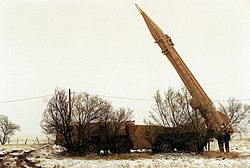Scud


SS-1 Scud är NATO:s rapporteringsnamn på en serie av taktiska ballistiska robotar som utvecklades av Sovjetunionen och som är inspirerad av den tyska V-2. Den officiella sovjetiska beteckningen på originalroboten var R-11 Zemlya.
Scudrobotar användes av Irak under Kuwaitkriget och av båda sidor i Iran–Irak-kriget. Irak tog hjälp av Gerald Bull för att förbättra sina Scudrobotar. Scudroboten har stått till grund för utvecklingen av många senare ballistiska robotar, bland annat den nordkoreanska Taepodong-2.
Varianter
Sovjetunionen
| Ryskt namn | GRAU-index | NATO-namn |
|---|---|---|
| R-11 Zemlya | 8А61 | SS-1A Scud |
| R-11M | 8К11 | SS-1B Scud A |
| R-17 Elbrus | 8К14 | SS-1C Scud B |
| R-17M | 8К14-1 | SS-1D Scud C |
| R-17FM | 8К14-1Ф | SS-1E Scud D |
Nordkorea
- Taepodong-1
- Taepodong-2
- Hwasong-5
- Hwasong-6
- Rodong-1
 Wikimedia Commons har media som rör Scud.
Wikimedia Commons har media som rör Scud.
| |||||||||||||||||||||||||||||||||||||
Media som används på denna webbplats
«Guards patch» to military personnel serving in Guards units, Guards formations, or Guards troops of the Red Army, version 1942.
Opposing forces set up a SCUD missile site for Exercise Roving Sands '97.
Members of the opposing forces provide a strong sense of reality for Exercise Roving Sands '97 participants as they set up a SCUD missile site at Roswell, N.M., on April 26, 1997. More than 20,000 service members from all branches of the armed forces of the U.S., Canada, Germany, and the Netherlands are participating in Exercise Roving Sands '97. The exercise is designed to refine their skills in operations using an integrated air defense network of ground, missile and radar early warning systems combined with tactical fighter and bomber aircraft operating in a simulated high-threat environment.




